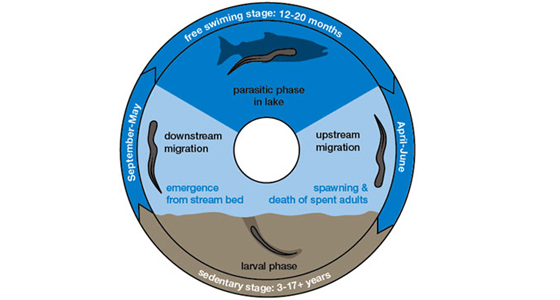Sea Lamprey
Kevin Rose | Smithsonian Environmental Research Center
The Sea Lamprey (petromyzon marinus) is an invasive species native to the Atlantic coasts of Europe and North America and the Mediterranean Sea. The Sea Lamprey is not native to the Great Lakes, but following the creation of ship canals and locks built to move ships from the coasts to the lakes, the fish entered and established itself throughout the Great Lakes region as early as the 1830s1.

Sea Lamprey do tremendous damage to the Great Lakes fisheries by consuming and often killing other fish, including trout and salmon. Image from 5.
The Sea Lamprey is considered a pest species and a parasite because it feeds on other fish, including many species favored by commercial and recreational fishermen. Looking much like an eel2, the Sea Lamprey attaches to other species and slowly consumes its prey. Often, the prey fish do not survive. Because of its parasitic nature, the Sea Lamprey is held responsible for the collapse of lake trout, whitefish, and chub populations in the Great Lakes in the 1940’s and 1950’s1.
Learn more about Sea Lamprey here: Predator In Paradise
The Sea Lamprey has been a successful invader in the Great Lakes for several reasons. First, while the Great Lakes have several native lamprey species, the Sea Lamprey is the largest and best competitor. Additionally, as an invasive, it lacks effective predators. Finally, the many miles of tributaries and streams provide ideal nesting habitat for young Sea Lamprey to grow and thrive2. However, research and management have been successful at controlling Sea Lamprey populations.

The Sea Lamprey has a complex life cycle. It is parasitic while in the Great Lakes, but also includes a larval stage where it remains in streams and tributaries of the Great Lakes for several years. Effective control has focused on this larval stage. Image from 6.
Sea Lamprey are controlled by a number of methods. One of the most successful methods had been the spraying of a chemical called TFM in streams where Sea Lamprey nest. The chemical kills larval and young lamprey1 but has a minimal effect on other fish species and is non-toxic to humans and other mammals3. With regular spraying, Sea Lamprey populations have been brought under control at about 10% of the peak decades ago3. In addition to TFM spraying, managers have built barriers to limit spawning in many places and an active trapping program is used to identify Sea Lamprey hotspots4.
Sources:
-
- United States Geological Survey. Upper Midwest Environmental Sciences Center: Sea Lamprey Density. View online
- Great Lakes Fishery Commission. TFM and Sea Lamprey Control – A Success Story. View online
- Great Lakes Fishery Commission. How are Sea Lampreys Controlled? View online
- Image from: http://en.wikipedia.org/wiki/File:Sea_Lamprey_fish.jpg
-
- Government of Canada. Sea Lamprey: The Battle Continues to Protect Our Great Lakes Fishery. View online









